Hello.
As some people may know I like to fix or restore old and cheap stuff for fun.
Today I bring you this stereo amplifier from around '96 which was taken from broken plastic speakers with the same cases as these:

Inside was this a very cheaply build TDA2616 based amp. Before taking them apart, I did listen to some music on it and, although the potentiometers being in very bad condition and making those typical raspy noises while turning them around, I couldn't stop noticing some actual good quality.
Before you start laugh and think I might be biased for only fixing cheap stuff, I did listen to very good speakers before so I can say that these are not too bad... maybe cheap PC speakers where not bad after all compared to those nowadays.
Have some pictures with the new components installed.
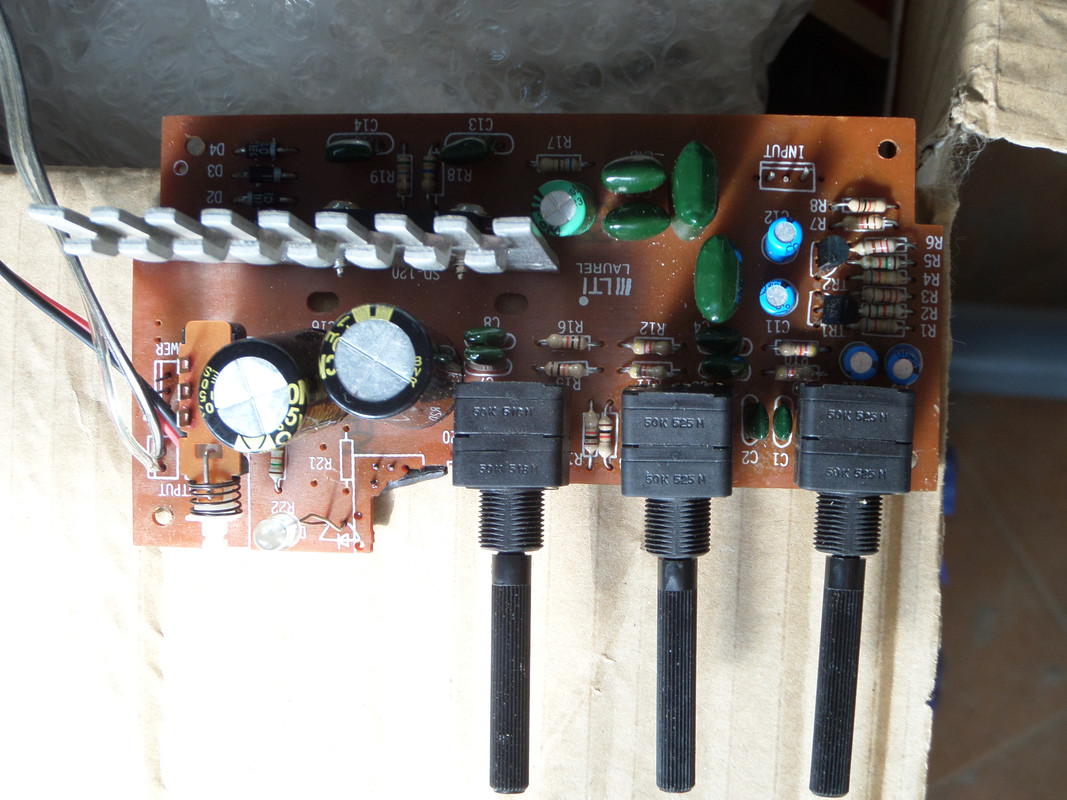
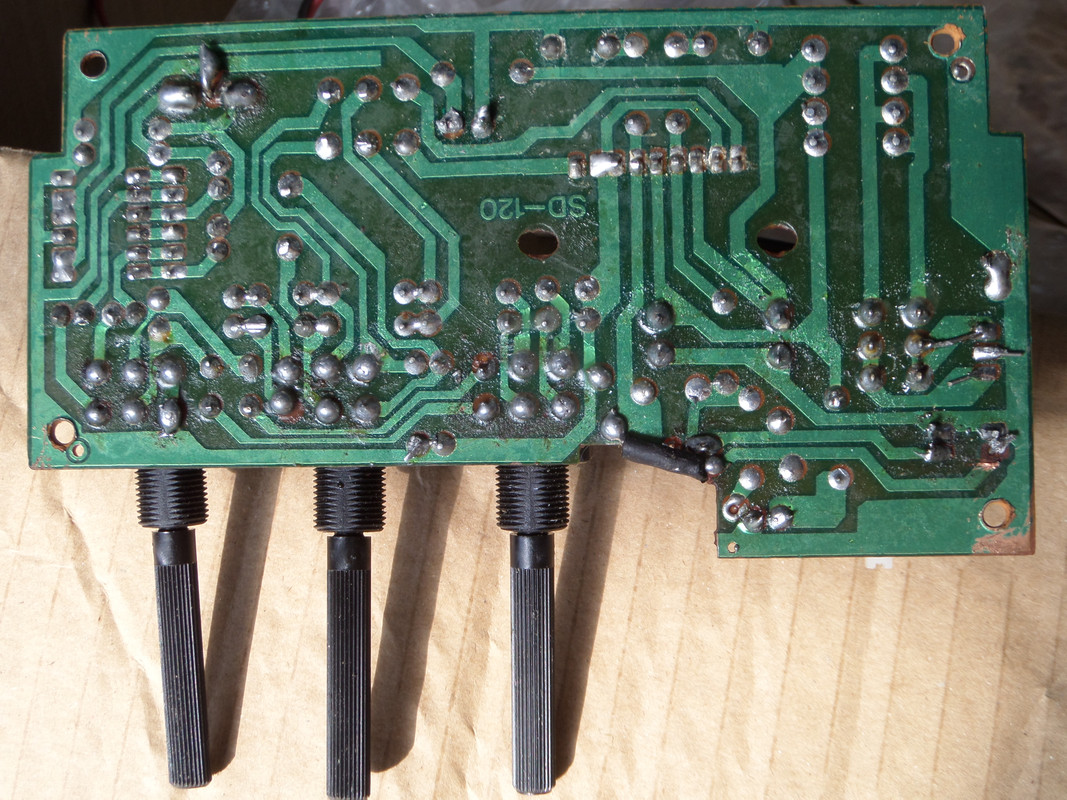
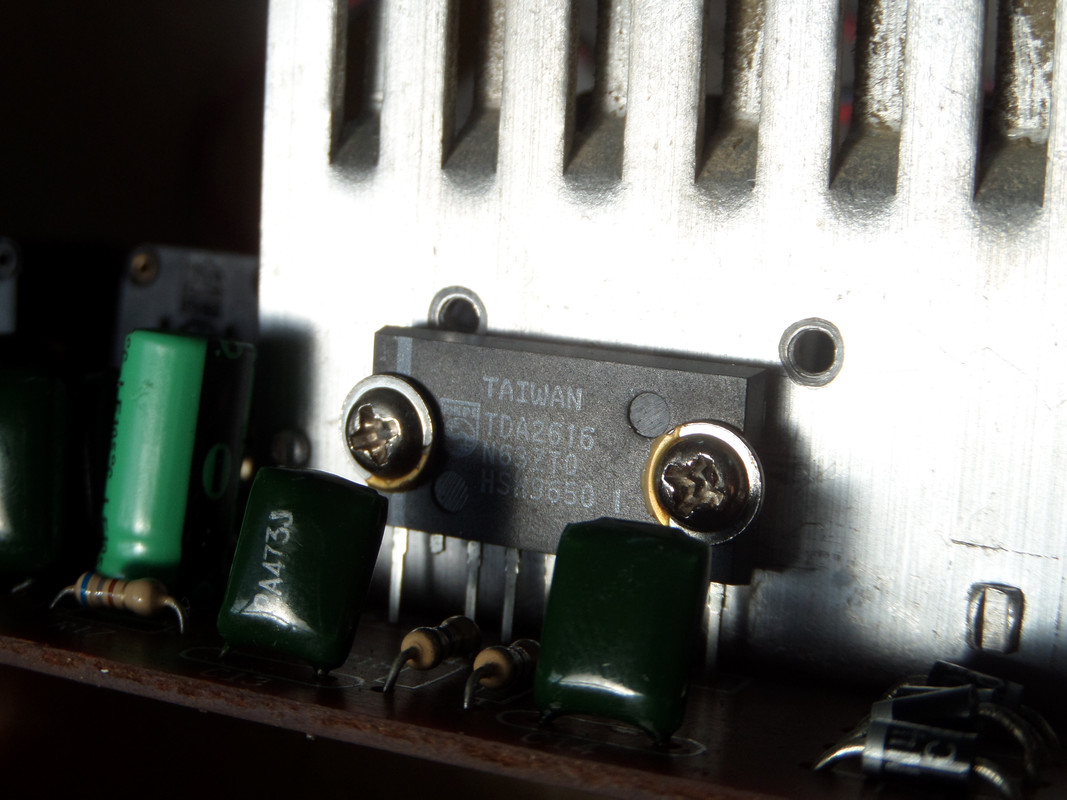
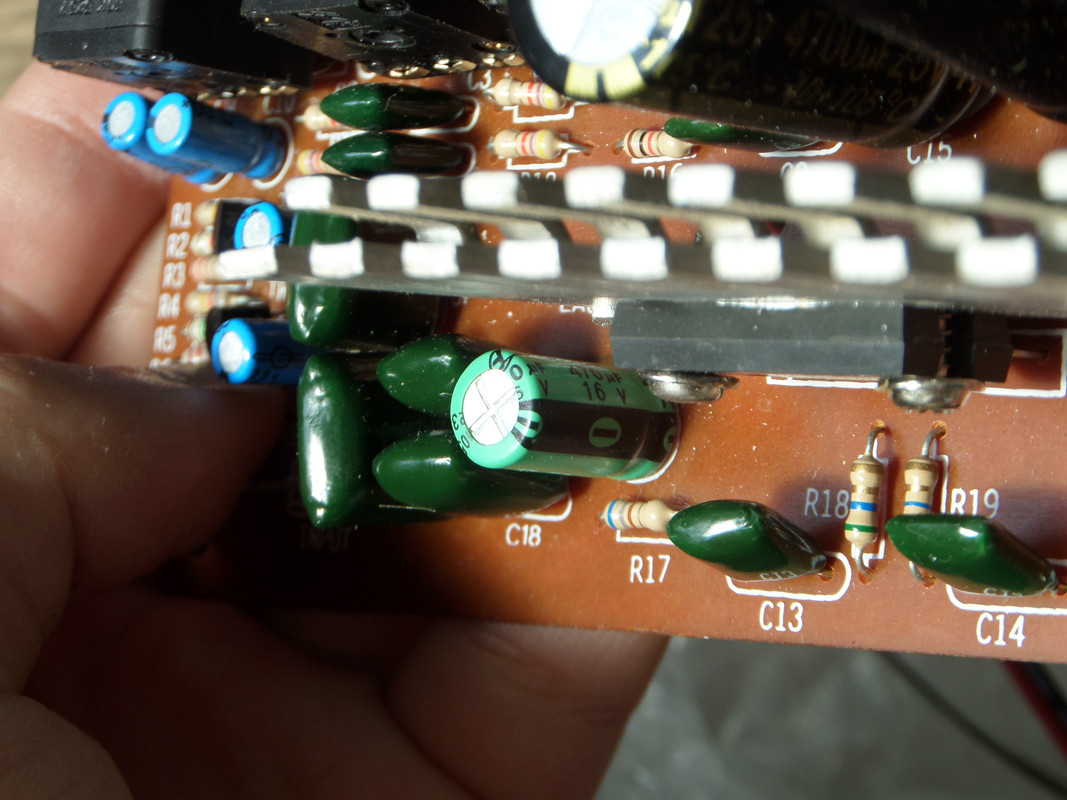
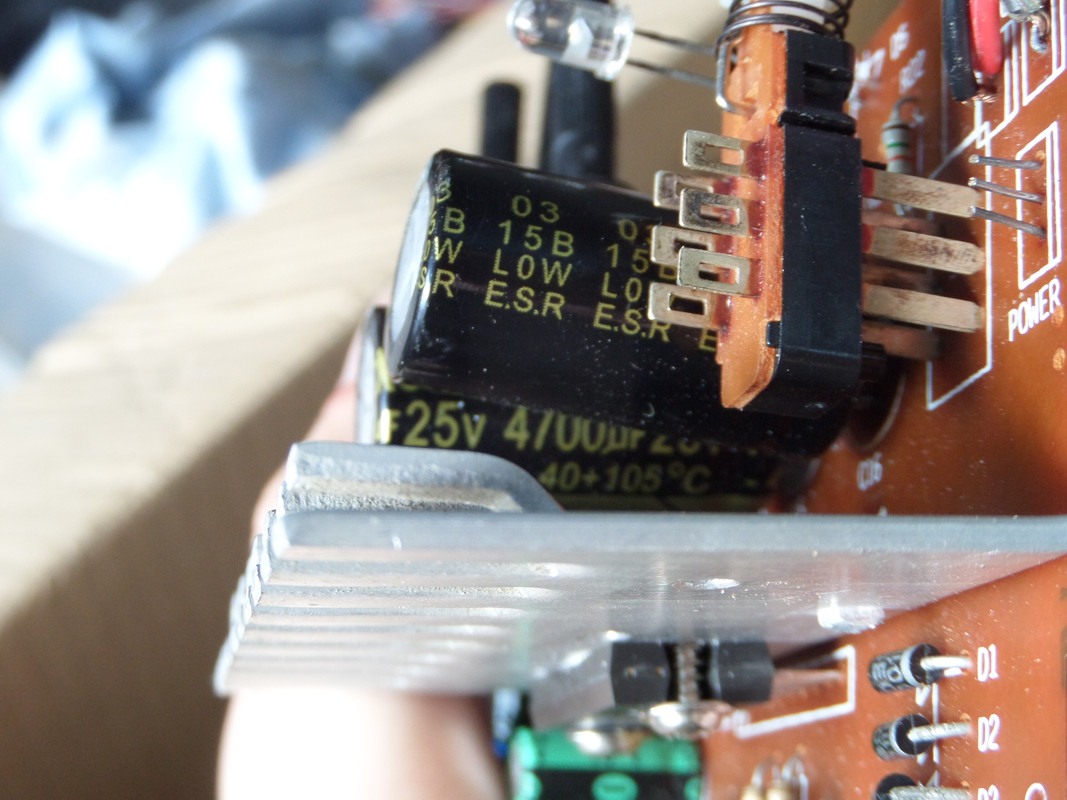
As you can see I put some quite big coupling capacitors for a bit less distortion while producing bass at higher volumes (btw I might be using the wrong terms since I'm new to this sort of things so, don't hesitate in correcting me if needed) I did also add that small green cap too but not sure what it is really for... filtering? No idea
I also did add new potentiometers, I showed the old ones to the very nice gentleman and he told me these ones I showed you above would be the best ones to buy.
The old ones looked like so:
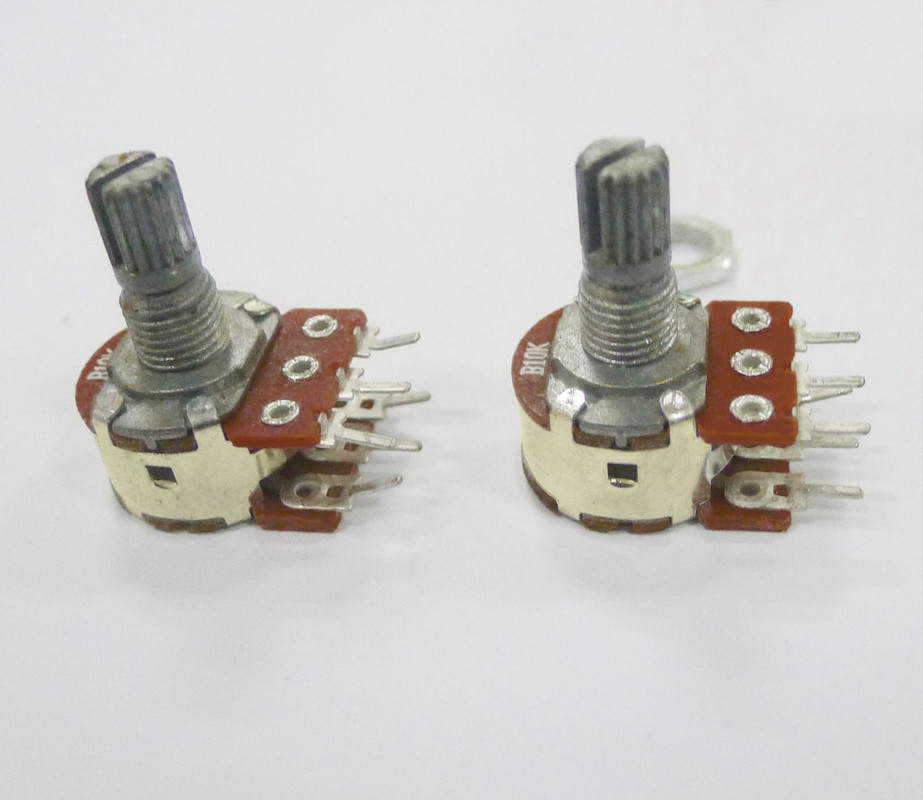
Only one problem... well quite of few of them appeared.
Using a dual-ac supply as needed by the board, the one I've got supplies about 12V AC, the following happened but also did not occur before the upgrade:
- DC passing to one channel while putting the volume potentiomer all the way "up" (which I presume, reducing resistance, right?)
- the diodes for the rectifier and the heat-sink did get a bit hot
- quite some parasite noises and also a bit of AC noise
Also: Note that the old potentiometers had a wire soldered between them over the chassis, and the two other units function as BASS and TREBLE filters.
For the diodes and the chip getting hot, I might have been passing a bit too much tension in the amplifier, since the old transformer only supplies between 8.5 to10V AC, but I'm still going to put "thicker" diodes in there just in case.
So, what did I did wrong here?
Thanks in advance for your time and attention.
Cheers and take care.
As some people may know I like to fix or restore old and cheap stuff for fun.
Today I bring you this stereo amplifier from around '96 which was taken from broken plastic speakers with the same cases as these:
Inside was this a very cheaply build TDA2616 based amp. Before taking them apart, I did listen to some music on it and, although the potentiometers being in very bad condition and making those typical raspy noises while turning them around, I couldn't stop noticing some actual good quality.
Before you start laugh and think I might be biased for only fixing cheap stuff, I did listen to very good speakers before so I can say that these are not too bad... maybe cheap PC speakers where not bad after all compared to those nowadays.
Have some pictures with the new components installed.





As you can see I put some quite big coupling capacitors for a bit less distortion while producing bass at higher volumes (btw I might be using the wrong terms since I'm new to this sort of things so, don't hesitate in correcting me if needed) I did also add that small green cap too but not sure what it is really for... filtering? No idea
I also did add new potentiometers, I showed the old ones to the very nice gentleman and he told me these ones I showed you above would be the best ones to buy.
The old ones looked like so:

Only one problem... well quite of few of them appeared.
Using a dual-ac supply as needed by the board, the one I've got supplies about 12V AC, the following happened but also did not occur before the upgrade:
- DC passing to one channel while putting the volume potentiomer all the way "up" (which I presume, reducing resistance, right?)
- the diodes for the rectifier and the heat-sink did get a bit hot
- quite some parasite noises and also a bit of AC noise
Also: Note that the old potentiometers had a wire soldered between them over the chassis, and the two other units function as BASS and TREBLE filters.
For the diodes and the chip getting hot, I might have been passing a bit too much tension in the amplifier, since the old transformer only supplies between 8.5 to10V AC, but I'm still going to put "thicker" diodes in there just in case.
So, what did I did wrong here?
Thanks in advance for your time and attention.
Cheers and take care.
If you get DC on the output with the volume turned all the way up or all the way down, my best guess is that the wiper actually lifts off the track. That's a pretty bad pot! Either replace the pot (preferred) or put a large resistor (~5-10x the resistance of the pot) from the wiper to signal ground. That'll ensure that the amp sees some impedance rather than an open circuit if the wiper lifts off the resistive track.
What you're describing could also be caused by a bad solder joint near the pot. I'm assuming you've checked for those already.
Tom
What you're describing could also be caused by a bad solder joint near the pot. I'm assuming you've checked for those already.
Tom
So what?Inside was this a very cheaply build TDA2616 based amp.
It won´t sound better or worse if tracks are made of Gold and soldering is pure Silver.
Or using $10 each resistors.
If it´s built as Philips suggests, then it will work fine,period.
I think the amp is excellent, like any modern one, but the weak point are speakers.Before taking them apart, I did listen to some music on it and, although the potentiometers being in very bad condition and making those typical raspy noises while turning them around, I couldn't stop noticing some actual good quality.
Not sure how could you notice quality through the original ones.
perhaps you mean the power supply capacitors?As you can see I put some quite big coupling capacitors for a bit less distortion while producing bass at higher volumes
Why would you add components at random without the least clue?I did also add that small green cap too but not sure what it is really for... filtering? No idea
All that matters is that they are the proper value and fit in the existing space.I also did add new potentiometers, I showed the old ones to the very nice gentleman and he told me these ones I showed you above would be the best ones to buy.
You meaan 12+12VAC?Only one problem... well quite of few of them appeared.
Using a dual-ac supply as needed by the board, the one I've got supplies about 12V AC,
Is it the original transformer?
How do you know?the following happened but also did not occur before the upgrade:
- DC passing to one channel while putting the volume potentiomer all the way "up"
no(which I presume, reducing resistance, right?)
You probably miswired or wrong soldered them.- the diodes for the rectifier and the heat-sink did get a bit hot
- quite some parasite noises and also a bit of AC noise
Old cases were probably grounded, new ones are plastic so you can´t.Also: Note that the old potentiometers had a wire soldered between them over the chassis, and the two other units function as BASS and TREBLE filters.
In any case, if you install your amp inside a properly grounded metallic chassis,you should have no problem.
The old transformer was perfectly adequate.For the diodes and the chip getting hot, I might have been passing a bit too much tension in the amplifier, since the old transformer only supplies between 8.5 to10V AC, but I'm still going to put "thicker" diodes in there just in case.
IF you replaced it, the question is why?
"Thicker" diodes won't help you.
You messed with a properly working amplifier.So, what did I did wrong here?
You should have cleaned the scratchy (dirty) pots and if not enough, replace them with exact same but new ones, period.
And you need to mount this amp inside a proper chassis and case.
Last edited:
Ricardo:
The pots seem to be Rohm, so good quality I presume.
Have You tried cleaning the PCB with Kontakt PCC (Green bottle) ?
I Also see broken PCB traces at the right pot...Soldering on the first pot touches the outer PCB track...
Please clean and revise all those soldering.
The pots seem to be Rohm, so good quality I presume.
Have You tried cleaning the PCB with Kontakt PCC (Green bottle) ?
I Also see broken PCB traces at the right pot...Soldering on the first pot touches the outer PCB track...
Please clean and revise all those soldering.
I Also see broken PCB traces at the right pot...Soldering on the first pot touches the outer PCB track...
The first pot is the volume pot. The end of it that the wiper hits when the volume knob is turned to minimum volume is the end that's connected to the outside trace on the board. That's probably a ground trace. That's the normal configuration for a volume pot.
You can see from the form factor of the board that it mounts upside down in the speaker. That may have led you astray.
Tom
The first pot is the volume pot. The end of it that the wiper hits when the volume knob is turned to minimum volume is the end that's connected to the outside trace on the board. That's probably a ground trace. That's the normal configuration for a volume pot.
You can see from the form factor of the board that it mounts upside down in the speaker. That may have led you astray.
Tom
I did eventually figured that out, and now I'm sure of it, thank you.
Also, manage to fix it, even thought I had to "repair" some of traces as multiple people saw, but yeah the board as always been in a bit of a bad shape, I think the speakers where stored in a humid place or something for quite a long time, some parts seem corroded if given a very close look.
Also, did give it a good clean, thankfully my uncled had some board cleaner around, wasn't in a green bottle thought
JMF, thank you for lightening me on the things I don't know
Well, at least it now it works and has pretty nice bass with almost no distortion (maybe the other caps where dead to). Cheers!
Not to shabby, almost funny cause i ripped the same ic off a tv board i found in the trash and plan on using it to make a small portable amp. I hate how old cheaply manufactured electronics have the most fragile traces. You can't beat old or cheap if it works well, especially if its to learn and tinker with, but my wife would probably disagree with my stash of junk...
- Status
- This old topic is closed. If you want to reopen this topic, contact a moderator using the "Report Post" button.
- Home
- Amplifiers
- Chip Amps
- Potentiometer upgrade causes DC to pass to speakers!?